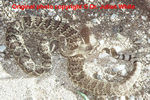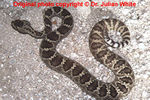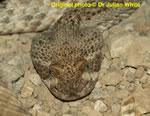|
Crotalus scutulatus
|
![Crotalus scutulatus ( Northern Mojave Rattlesnake ) subsp. scutulatus [ Original photo copyright © Dr Julian White ]](images/snakes/SNP04691.jpg)
|
|
Family: Viperidae
|
|
Subfamily: Crotalinae
|
|
Genus: Crotalus
|
|
Species: scutulatus
|
|
Subspecies: scutulatus
|
Common Names
( subsp. scutulatus ) Northern Mojave Rattlesnake
|
Local Names
Cascabel Llanera , Chiauhcoatl , Vibora , Vibora de Cascabel
|
Region
North America + Central America
|
Countries
Mexico, United States of America
|
|

|
|
|
|
Taxonomy and Biology
|
|
Adult Length: 0.70 m
|
General Shape
Small to medium in length, medium bodied rattlesnake with a short tail and horn-like segmented rattle. Can grow to a maximum of about 1.37 metres. Head is large, broad, rounded triangular and very distinct from narrow neck. Eyes are medium to moderately small in size with vertically elliptical pupils. Dorsal scales are keeled.
|
Habitat
Elevations up to at least 2500 metres. Mainly desert and mesquite-grassland and woodland, but extending into pine-oak forest fringes.
|
Habits
Terrestrial and diurnal snake with nocturnal tendencies in the hottest months.
|
Prey
Feeds mainly on lizards, rodents, small mammals and birds.
|
|
|
|
Venom
|
Average Venom Qty
50 to 90 mg ( dry weight ), Minton (1974) ( Ref : R000504 ).
|
General: Venom Neurotoxins
Presynaptic neurotoxins
|
General: Venom Myotoxins
Secondary myotoxic activity may be present
|
General: Venom Procoagulants
Possibly present
|
General: Venom Anticoagulants
Not present
|
General: Venom Haemorrhagins
Present but not defined
|
General: Venom Nephrotoxins
Not present
|
General: Venom Cardiotoxins
Not present
|
General: Venom Necrotoxins
Not present
|
General: Venom Other
May include; Lectins; Nerve growth factors; Phospholipase inhibitors; Proteinase inhibitors; Complement inactivators; Biogenic amines; Carbohydrates; Lipids; Nucleosides & nucleotides
|
|
|
|
Clinical Effects
|
General: Dangerousness
Severe envenoming possible, potentially lethal
|
|
General: Rate of Envenoming: 40-60%
|
|
General: Untreated Lethality Rate: 30-40%
|
General: Local Effects
Lack of data precludes accurate description, but if significant effects occur, most likely to be either (1) major local effects ± coagulopathy or (2) minor local effects with flaccid paralysis ± myolysis
|
General: Local Necrosis
Not likely to occur
|
General: General Systemic Effects
Variable non-specific effects which may include headache, nausea, vomiting, abdominal pain, diarrhoea, tachypnoea, respiratory distress, hypotension, dizziness, collapse or convulsions
|
General: Neurotoxic Paralysis
Most cases will show minimal paralytic features, if any, but more severe paralysis can occur
|
General: Myotoxicity
In some cases, severe systemic myotoxicity can occur
|
General: Coagulopathy & Haemorrhages
In cases with marked local effects, coagulopathy and thrombocytopenia can occur, but major bleeding is unlikely
|
General: Renal Damage
Insufficient clinical reports to know, but in cases with marked myolysis, secondary renal failure is a significant risk
|
General: Cardiotoxicity
Insufficient clinical reports to know, but in cases with marked myolysis, secondary cardiotoxicity due to hyperkalaemia is a significant risk
|
General: Other
Shock secondary to fluid shifts due to local tissue injury is likely in severe cases
|
|
|
|
First Aid
|
|
Description: First aid for bites by Viperid snakes not likely to cause significant injury at the bite site or where general (systemic) effects are likely to be more important than local effects (see listing in Comments section).
|
Details
1. After ensuring the patient and onlookers have moved out of range of further strikes by the snake, the bitten person should be reassured and persuaded to lie down and remain still. Many will be terrified, fearing sudden death and, in this mood, they may behave irrationally or even hysterically. The basis for reassurance is the fact that many venomous bites do not result in envenoming, the relatively slow progression to severe envenoming (hours following elapid bites, days following viper bites) and the effectiveness of modern medical treatment.
2. The bite wound should not be tampered with in any way. Wiping it once with a damp cloth to remove surface venom is unlikely to do much harm (or good) but the wound must not be massaged.
3. All rings or other jewellery on the bitten limb, especially on fingers, should be removed, as they may act as tourniquets if oedema develops.
4. If the bite is on a limb, a broad bandage (even torn strips of clothing or pantyhose) should be applied over the bitten area at moderate pressure (as for a sprain; not so tight circulation is impaired), then extended to cover as much of the bitten limb as possible, including fingers or toes, going over the top of clothing rather than risking excessive limb movement by removing clothing. The bitten limb should then be immobilised as effectively as possible using an extemporised splint or sling.
5. If there is any impairment of vital functions, such as problems with respiration, airway, circulation, heart function, these must be supported as a priority. In particular, for bites causing flaccid paralysis, including respiratory paralysis, both airway and respiration may be impaired, requiring urgent and prolonged treatment, which may include the mouth to mask (mouth to mouth) technique of expired air transfer. Seek urgent medical attention.
6. Do not use Tourniquets, cut, suck or scarify the wound or apply chemicals or electric shock.
7. Avoid peroral intake, absolutely no alcohol. No sedatives outside hospital. If there will be considerable delay before reaching medical aid, measured in several hours to days, then give clear fluids by mouth to prevent dehydration.
8. If the offending snake has been killed it should be brought with the patient for identification (only relevant in areas where there are more than one naturally occurring venomous snake species), but be careful to avoid touching the head, as even a dead snake can envenom. No attempt should be made to pursue the snake into the undergrowth as this will risk further bites. In Australia and parts of New Guinea, Snake Venom Detection Kits are available to identify the snake from venom left on the skin.
9. The snakebite victim should be transported as quickly and as passively as possible to the nearest place where they can be seen by a medically-trained person (health station, dispensary, clinic or hospital). The bitten limb must not be exercised as muscular contraction will promote systemic absorption of venom. If no motor vehicle or boat is available, the patient can be carried on a stretcher or hurdle, on the pillion or crossbar of a bicycle or on someone's back.
10. Most traditional, and many of the more recently fashionable, first aid measures are useless and potentially dangerous. These include local cauterization, incision, excision, amputation, suction by mouth, vacuum pump or syringe, combined incision and suction ("venom-ex" apparatus), injection or instillation of compounds such as potassium permanganate, phenol (carbolic soap) and trypsin, application of electric shocks or ice (cryotherapy), use of traditional herbal, folk and other remedies including the ingestion of emetic plant products and parts of the snake, multiple incisions, tattooing and so on.
|
|
|
|
Treatment
|
Treatment Summary
Bites by Mojave rattlesnakes usually cause moderate to severe local effects and mild coagulopathy, typical of other rattlesnake bites, requiring good wound care, IV fluids and IV antivenom. However, a minority of cases will cause minor local effects, but major systemic effects (paralysis & myolysis), the early features of which may easily be missed. Antivenom therapy is the only effective treatment. All cases, even those appearing minor initially, must be observed at least overnight.
|
Key Diagnostic Features
Local pain, swelling, blistering, rarely necrosis + mild coagulopathy OR minor local effects + myolysis ± flaccid paralysis
|
General Approach to Management
All cases should be treated as urgent & potentially lethal. Rapid assessment & commencement of treatment including appropriate antivenom (if indicated & available) is mandatory. Admit all cases.
|
Antivenom Therapy
Antivenom is the key treatment for systemic envenoming. Multiple doses may be required.
|
| 1. Antivenom Code: SAmPRO01
|
|
Antivenom Name: Polyvalent crotalid antivenom ( CroFab ), Ovine, Fab
|
|
Manufacturer: Protherics Inc. (US)
|
|
Phone: ++1-615-327-1027
|
Address: 5214 Maryland Way
Suite 405
Brentwood
Tennessee 37027
USA
|
|
Country: U.S.A.
|
| 2. Antivenom Code: SAmIBM06
|
|
Antivenom Name: Antivipmyn
|
|
Manufacturer: Instituto Bioclon
|
|
Phone: ++56-65-41-11
|
Address: Calzada de Tlalpan No. 4687
Toriello Guerra
C.P. 14050
Mexico, D.F.,
|
|
Country: Mexico
|
|
|
|
Images
|

|

|

|

|
|
|
|
Crotalus scutulatus ( Northern Mojave Rattlesnake ) subsp. scutulatus [ Original photo copyright © Dr Julian White ]
|
Crotalus scutulatus ( Northern Mojave Rattlesnake ) subsp. scutulatus [ Original photo copyright © Dr Julian White ]
|
Crotalus scutulatus ( Northern Mojave Rattlesnake ) subsp. scutulatus [ Original photo copyright © Dr Julian White ]
|
Crotalus scutulatus ( Northern Mojave Rattlesnake ) subsp. scutulatus [ Original photo copyright © Dr Julian White ]
|
|
|
|
|
|



